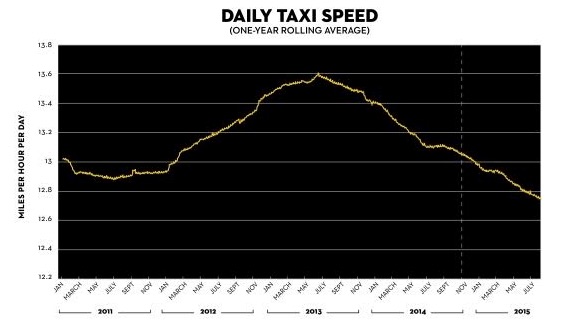
Maybe it’s the sleekness. Or the digital disruptiveness. Or something slipped in the water bottle on your seat. Whatever it is, some data mavens are contorting into pretzels to deny the obvious -- that Uber is contributing to the slowdown in Manhattan traffic.
The latest Don’t Blame Uber entry was a New Yorker post over the weekend by Ben Wellington, a Pratt statistics prof and mainstay of the “Open Data Movement” via his I Quant NY website. “Uber Isn’t Causing New York City’s Traffic Slowdown,” screamed the headline, though curiously, Wellington didn’t quite write that.
Here’s the gist of his post:
At the start of 2013, cabs were getting faster by about 0.0015 miles per hour per day. By mid-2014, they were getting slower by about 0.0013 miles per hour per day -- or about one mile per hour every two years. In other words, every day, cabs were getting slower less quickly than they had the previous day, even as Uber was expanding its fleet. This is the opposite of what we would expect if for-hire vehicles were the main force behind falling traffic speeds.
Let’s unpack that.
First, mining the Taxi and Limousine Commission’s humongous database of all yellow taxicab trips from 2011 through last month -- the period in which yellows have been GPS-capable -- Wellington computed daily and monthly average speeds for the entire fleet (excluding ultra-long trips that might skew the averages). As the graph shows, average taxi speeds climbed from 2011 before peaking in mid-2013 and heading south. This dovetails with City Hall’s insistence that traffic in the Manhattan core has been worsening, although the drop in Wellington’s graph is less severe than the city’s figures.
So far, so good. Wellington then zeroed in on the rates of change in speeds and produced the quoted passage above. Since use of Uber really took off only around two years ago, it makes more sense to focus on the most recent 24 months. Eyeballing Wellington’s graph, average cab speeds fell an estimated 0.48 miles an hour from mid-2013 to mid-2014 and another 0.32 mph from mid-2014 to mid-2015. In effect, the decline in speeds shrank by a third. Because Uber’s presence on NYC streets has been accelerating, he reasoned, the slowdown should have been getting more pronounced, not less.
Since it didn’t, something other than Uber must have caused the slowdown.
Q.E.D.? No. For a host of reasons:
- No one is blaming Uber for all or even most of the slowdown in Manhattan traffic. In a recent post I charged it with around 40 percent. The factors making up the remaining 60 percent could have been more potent in 2013 and early 2014 and less so later.
- Cabbies may have been slow to react to the drop in hails as Uber gained market share. If yellows didn’t start trimming their shifts in earnest until late 2014, the steeper decrease in cruising after then could have tempered the drop in speeds that would have been expected from the growth in Uber.
- Perhaps revulsion over yellow drivers’ maiming of Sian Green in August 2013 and killing of Cooper Stock in January 2014 led cabbies to operate more cautiously -- by yielding in crosswalks, say. This could have contributed to slower speeds for a time, until the effects of NYPD enforcement or social opprobrium fell away.
- Regression to the mean: the mid-2013 peak in speeds might have been a statistical aberration that made the ensuing decline appear more pronounced.
“Traffic is an incredibly complicated thing, and the people who argue about it are prone to overstating their cases.” That’s how Wellington concluded his New Yorker post, though this precept may have eluded the headline writer.
There’s actually much to like in that post, including Wellington’s enterprising and skillful translation of data for an estimated three-quarters of a billion trips, and his exculpation of the citywide 25 mph speed limit (that’s what the vertical dotted line in the graph denotes) from major responsibility for the slower speeds. But what seems to suffuse the piece, as well as earlier ones in FiveThirtyEight and the New York Times, is a reluctance to apprehend two basic truths about Manhattan traffic.
First, removing hurdles to using automobiles leads to increased use. Second, additional use of autos in a congested environment like the Manhattan Central Business District contributes to a general slowing down of all autos. (In a post last month I reported that an average mile driven by a single automobile in the CBD slows down all other vehicles there by a combined 10 minutes, though the figure varies widely by time of day.)
These realities may lack Uber’s glamour. But they’re no less real -- on both sides of the windshield.





